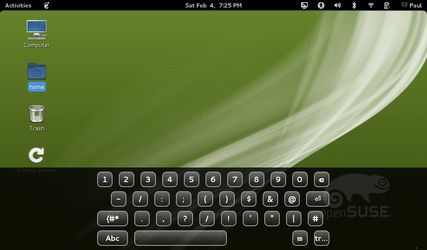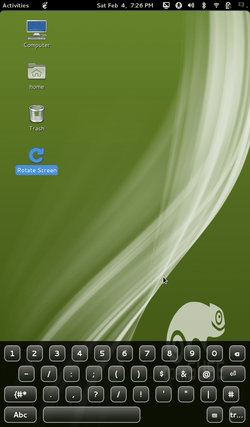Since the Viewpad 10 has an Intel CPU, Linux can be installed on it very easily. On the most recent versions of Linux, the touchscreen even works out-of-the-box. What doesn't seem to work is screen rotation, and the proper touchscreen orientation after the screen rotaton.
I have a cousin of the Viewpad 10, the Azpen X1. I have installed openSUSE Linux 12.1-Gnome on it, because it seems to offer a better Desktop for touching. Here is what I had to do to get a screen rotation button working on my desktop.
First, you need to know the name of your touchscreen. I used the xinput list command for this:
My touchpad is the entry highlighted in red. If your touchscreen is different, use that in the following script.
I then used the touchscreen name in a sh script, this script is a heavily modified version of one that I found on the internet.
Save it as rotate.sh. In the first use of xinput, the word Axes is not misspelled! You can run this script from the terminal, but first make it executable. I store mine in a Scripts folder, so I ran this:
Then run it, and it will rotate the screen and touchscreen to the right:
Running it a second time will return the screen to Normal view. If you just hit the up arrow on the keyboard, it will display the last command entered.
Now to put a shortcut on the desktop to run the script. You first have to install the gnome-tweak-tool. I believe this is the same in Ubuntu. Open gnome tweak-tool (Applications-->Advanced Settings). Click on the Desktop section, and turn on "Have file manager handle the desktop". You can also then enable any of the other setting in that category that you want shown on the Desktop, and close it.
Then open a text editor, I use gedit. Then create this file:
Make sure the Exec= is the path to the folder with the rotate.sh script in it. Also, make sure the Icon= path is to an actual icon on your system. Then save the file in your Desktop folder as "Rotate Screen.desktop" (without the quotes). You now should have an icon on your Desktop. Double-touching it should rotate your screen to the right. Double-touching it again will return it to normal.
Enjoy!
I have a cousin of the Viewpad 10, the Azpen X1. I have installed openSUSE Linux 12.1-Gnome on it, because it seems to offer a better Desktop for touching. Here is what I had to do to get a screen rotation button working on my desktop.
First, you need to know the name of your touchscreen. I used the xinput list command for this:
Code:
xinput list
⎡ Virtual core pointer id=2 [master pointer (3)]
⎜ ↳ Virtual core XTEST pointer id=4 [slave pointer (2)]
⎜ ↳[COLOR=#ff0000] ILITEK ILITEK Multi-Touch[/COLOR] id=9 [slave pointer (2)]
⎜ ↳ Logitech USB Receiver id=12 [slave pointer (2)]
⎜ ↳ Logitech USB Receiver id=13 [slave pointer (2)]
⎣ Virtual core keyboard id=3 [master keyboard (2)]
↳ Virtual core XTEST keyboard id=5 [slave keyboard (3)]
↳ Power Button id=6 [slave keyboard (3)]
↳ Video Bus id=7 [slave keyboard (3)]
↳ Power Button id=8 [slave keyboard (3)]
↳ USB2.0-Camera id=10 [slave keyboard (3)]
↳ AT Translated Set 2 keyboard id=11 [slave keyboard (3)]
↳ SCISSORS Keyboard id=14 [slave keyboard (3)]I then used the touchscreen name in a sh script, this script is a heavily modified version of one that I found on the internet.
Code:
#!/bin/sh
# Find the line in "xrandr -q --verbose" output that contains current screen orientation and "strip" out current orientation.
rotation="$(xrandr -q --verbose | grep 'connected' | egrep -o '\) (normal|left|inverted|right) \(' | egrep -o '(normal|left|inverted|right)')"
# Using current screen orientation proceed to rotate screen and input tools.
case "$rotation" in
normal)
# -rotate to the right
xrandr -o right
xinput set-prop --type=int --format=8 "ILITEK ILITEK Multi-Touch" "Evdev Axes Swap" 1
xinput set-prop --type=int --format=8 "ILITEK ILITEK Multi-Touch" "Evdev Axis Inversion" 0 1
xinput set-prop --type=int --format=8 4 "Evdev Axis Inversion" 0 1
;;
right)
# -rotate to normal
xrandr -o normal
xinput set-prop --type=int --format=8 "ILITEK ILITEK Multi-Touch" "Evdev Axes Swap" 0
xinput set-prop --type=int --format=8 "ILITEK ILITEK Multi-Touch" "Evdev Axis Inversion" 0 0
xinput set-prop --type=int --format=8 4 "Evdev Axis Inversion" 0 0
;;
esac
Code:
chmod +x ~/Scripts/rotate.sh
Code:
~/Scripts/rotate.shNow to put a shortcut on the desktop to run the script. You first have to install the gnome-tweak-tool. I believe this is the same in Ubuntu. Open gnome tweak-tool (Applications-->Advanced Settings). Click on the Desktop section, and turn on "Have file manager handle the desktop". You can also then enable any of the other setting in that category that you want shown on the Desktop, and close it.
Then open a text editor, I use gedit. Then create this file:
Code:
#!/usr/bin/env xdg-open
[Desktop Entry]
Encoding=UTF-8
Version=1.0
Name=Rotate
Comment=Rotate Screen
Type=Application
Exec=/home/paul/Scripts/rotate.sh
Icon=/usr/share/icons/gnome/48x48/actions/view-refresh.png
Terminal=false
Catagories=Settings
StartupNotify=true
Name[en_US]=Rotate ScreenEnjoy!
Last edited:




